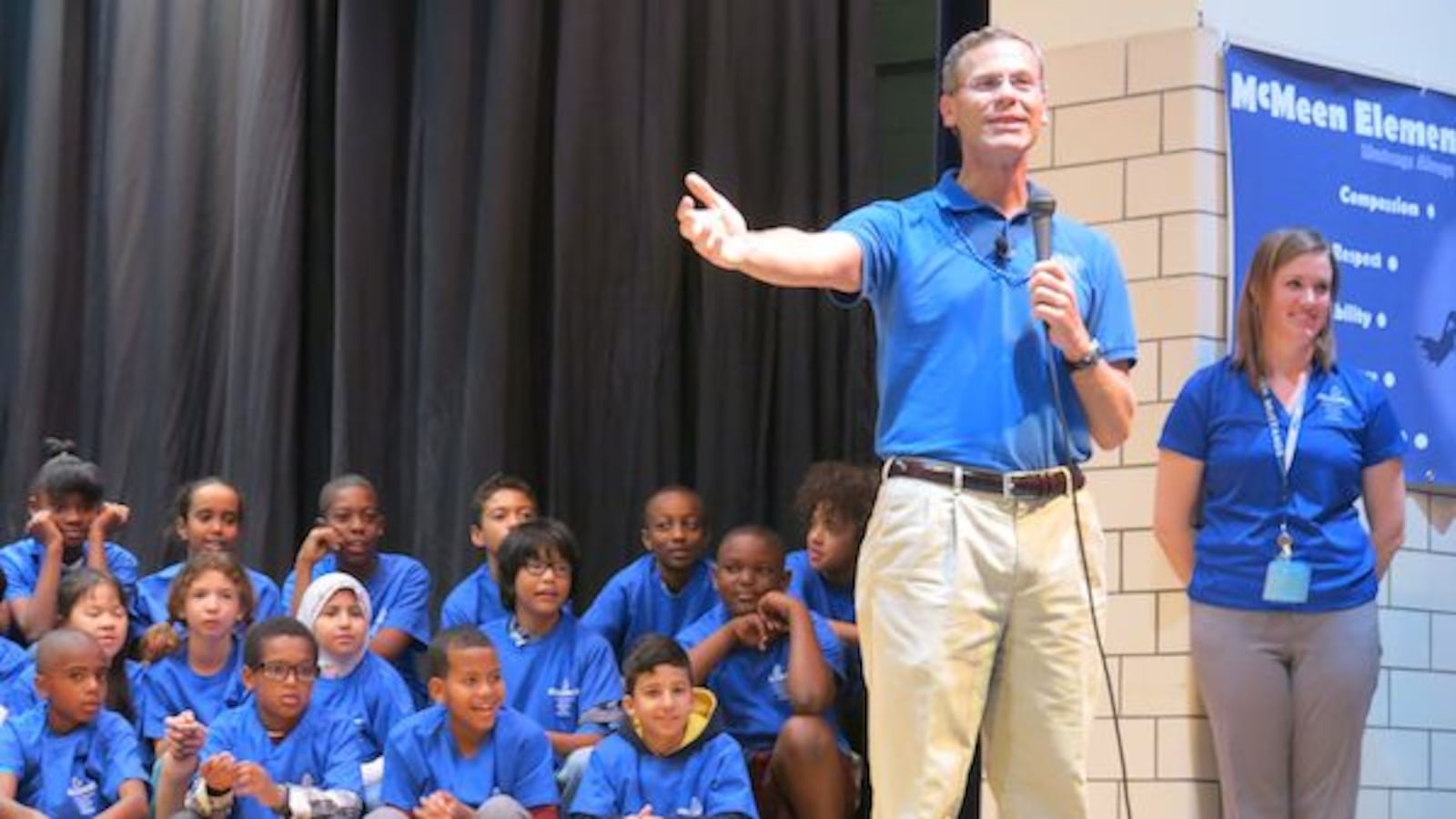A sea of elementary schoolers crowded into McMeen Elementary School in southeast Denver on Monday morning were eager to tell their superintendent Tom Boasberg what made their school great. “We have good teachers,” said one student. “We respect other people,” said another. “It’s fun!” said a third.
Boasberg had a more specific reason: This was the fifth year McMeen earned the top ranking, “blue,” on the district’s school performance framework, released Monday morning.
“What it means to be blue is you’re learning and you’re growing,” Boasberg said.
Explore Chalkbeat’s database of this year’s school rankings.
The number of schools in Denver earning top marks on the district’s school performance framework increased this year, but the number of schools in the lowest category also increased for the second year in a row.
The district has set a goal of having 80 percent of its students in green or blue schools by 2020, as part of its Denver Plan. Today, 60 percent of students in the district are attending schools ranked either green or blue—down one percent from last year.
“There are some really strong spots and some clear areas of concern,” Boasberg told Chalkbeat on Monday.
Overall, 92 of the district’s 185 Denver schools earned a green or blue ranking, the top two levels. McMeen was one of 27 “blue” schools in the district. That’s part of a steady upward trend, according to district officials. But the number of “red” schools—identified as the lowest-performing in the city—increased again this year, from 25 in 2013 to 31.
The district’s charter schools were disproportionately represented in both the top two and bottom two categories: Eleven of the district’s 26 blue schools, or more than two-fifths of the high-ranking schools, were charters, though charters make up just one-fifth of the district’s schools. At the same time, 11 of the district’s 32 charters were in the bottom two categories.
The district’s efforts to increase the number of schools into the top categories will be complicated by two policy changes that go into effect next year. State and local officials have predicted that scores on the state’s new set of standardized assessments, PARCC, are likely to be lower than scores on TCAP, the current testing system. That’s likely to have a ripple effect on the school’s ratings and accountability measures but the district hasn’t decided how they plan to handle those impacts.
The district is also in the process of adjusting the formula it uses to evaluate schools. Beginning next year, rankings will give more weight to schools’ absolute scores rather than to measures of how much progress students made compared to their peers.
The rankings are based students’ performance on standardized tests and a group of additional measures, including what percent of students reenroll in the school and what percentage of parents respond to a survey.
The School Performance Framework gives schools a grade out of 100 points and a color-coded status. Schools are coded as red (on probation); orange and yellow (on a “watch list”); green (“meets expectations”); or blue. The state, which uses the same terms but a different performance framework, will be releasing its scores later this year. The district also rates its early education programs and alternative programs using specially-tailored frameworks.
The rankings carry the most impact for the “red” schools, which are subject to school improvement efforts ranging from increased professional development for teachers to bringing in entirely new leadership or management.
“We were struck by and disappointed the increased number of red schools,” Boasberg said “There will absolutely be changes in all of those schools.”
Several schools that made progress in previous years slipped back into the lowest ranking, including Schmitt Elementary and the district’s all-boys charter school, Sims-Fayola International Academy.
Sims-Fayola’s charter contract is up for renewal this year. Students made an impassioned plea for the school’s survival at Denver’s board meeting last week.
Boasberg said the district should focus on retaining high-quality teachers in struggling schools by shoring up the supports teachers receive and pay incentives for working in low-performing schools. Teachers currently receive a $2,500 bonus; “that’s not nearly enough,” he said.
At successful schools, Boasberg said, “it’s not a complicated formula – you see good teaching, good leadership and a strong culture.”
Boasberg singled out improvements the district’s middle schools.
“Middle school is where we’ve seen the deepest push on many of our reforms,” he said. He said many of the district’s middle schools, both charter and traditional, are now smaller and higher-performing than in the past.
Three new middle schools—Hamilton, KIPP’s Montbello campus and DSST: Byers — joined the list of schools that met or exceeded expectations. Denver charter network’s STRIVE’s Lake campus dropped off the list, part of a pattern of declines at STRIVE schools.
Boasberg said the performance framework’s measures “all come together to form an overall view of each school. He urged parents and teachers to look both at schools’ performance and at individual children’s scores. “Every parent wants to know, is my kid learning or growing?”
Parents at McMeen today said that the rankings confirmed what they already knew about their school and its teachers.
“When we moved here from Littleton, I remember pulling in and seeing the ‘school of excellence’ banner,” said Shelley Keoppel, who has second and fourth graders at the school. “But it’s really being here, the more you’re involved, that you become more aware of what’s going well.”

